Bulletin – September 2018 Finance Money in the Australian Economy
- Download 574KB
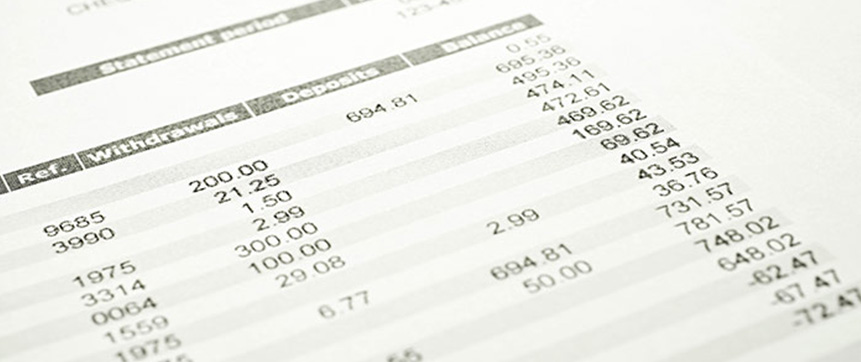
Abstract
Money forms part of our everyday lives and is integral to the smooth functioning of the financial system and the real economy; however, discussions of what money is and how it is created are generally left to economics textbooks. This article provides an introduction to the concept of money and describes how it is created and measured. We also discuss what these measures can tell us about economic activity.
What Is Money?
Characteristics of money
In the most general sense, money refers to something that is widely accepted as means of payment – commonly referred to as a medium of exchange in economics textbooks. What is ‘widely accepted’ depends on the context. For example, Japanese yen are widely accepted as a means of payment for goods or services purchased in Japan, but not in Australia. Similarly, whereas rum was widely accepted as a means of payment in the early days of Australian colonisation, the same cannot be said of today. This contextual element highlights that whether something is considered to be money or not is at least partly the result of convention – that is, a situation has arisen where people believe that this something called money will be accepted as a means of payment and, as such, they believe there will be continuing value in holding this form of money in order to make future payments.
This belief that there will be continuing value in holding money as a method of making future payments touches on a second property of money: it tends to be a good store of value. If you are going to hold money primarily for the purpose of purchasing other goods or services, it is important that it holds its value over time. If a type of money was not a good store of value, you would want to spend it quickly because its purchasing power would decrease over time.[1]
In addition to the two properties above, a third common property of money is that it is used as a unit of account. For example, it is common for prices to be expressed in terms of the number of units of the money that is widely accepted as a means of payment. For example, the price of a cup of coffee is expressed as the number of Australian dollars required. If it were expressed in terms of some other unit of account (e.g. a foreign currency) then the current exchange rate between Australian dollars and that other unit of account (e.g. US dollars) would need to be known to all parties participating in the transaction.
All goods exhibit ‘money-like’ qualities to varying degrees.[2] Non-perishable goods typically serve as a store of value for some period; most goods can be used as a medium of exchange, albeit with varying difficulties; and any good can be used as a unit of account, although the calculus required to value one good in terms of another is often inconvenient. Institutional settings – such as the currency recognised by the government as a means of paying taxes (and receiving benefits) – often play an important role in determining what becomes accepted as money in an economy. While there is typically nothing stopping the use of other currencies for private transactions, in most modern economies, convenience and convention have resulted in just one type of money becoming the medium of exchange and unit of account.[3],[4] In Australia, that type of money is Australian dollars, although this money can take a number of forms.
Types of money
What constitutes money has evolved over time. ‘Box A: Early Forms of Money in Australia’ summarises some of the different types of money used in Australia's colonial period.
The two forms of money most commonly used to make payments in modern day Australia are currency – Australian banknotes and coins – and Australian dollar deposits.[5] Both can be used readily as means of payment for goods and services in Australia, the prices of which are typically expressed in Australian dollars. The Reserve Bank has a role in ensuring that Australian dollar currency and deposits are a good store of value: by achieving a low and stable rate of inflation, the Reserve Bank helps to maintain stability in the purchasing power of Australian dollars (both in terms of currency and deposits). Also, prudential regulation and supervision helps to ensure that deposits are a good store of value by ensuring that authorised deposit-taking institutions (ADIs) are able to meet the demands of their depositors in full.[6]
Box A
Early Forms of Money in
Australia[7]
When the colony of New South Wales was established in 1788, colonists relied on barter and used rum (spirits) as a makeshift currency. In 1792, a shipment of Spanish dollars was sent to Australia for use as currency alongside the other international currencies that were used in the colony at the time. To address persistent coin shortages, new forms of money were developed in the following decades. These included the creation of the holey dollar and dump by Governor Macquarie (which made two coins out of one), the use of promissory notes or IOUs, and copper tokens issued by businesses. IOUs and copper tokens proved an unreliable source of currency, partly because they had no official guarantee.
In 1825, the British Government legislated a sterling currency for the colony, which remained the basis of Australian currency until the transition to decimal currency, the Australian dollar, in 1966. Australia's first gold coins were minted in 1855. The gold rushes spurred the development of banking and commercial banks issued banknotes backed by gold, though these banknotes did not constitute a national currency. Like many other countries at the time, Australia adhered to the gold standard and the total amount of notes that banks could issue was limited by their gold reserves. At the turn of the twentieth century, Australia's currency remained a mixture of British coins, Australian coins and the notes of private banks and the Queensland Government.
In 1910, legislation for a national currency was enacted. The Australian Government issued ‘superscribed’ banknotes, whereby words were overprinted on notes purchased from the private banks. These were the first currency notes accepted across the nation. The first true Australian banknote was produced in May 1913, with additional denominations produced during 1913 to 1915.
How Is Money Created?
Australia's notes and coins are produced by the Reserve Bank of Australia and the Royal Australian Mint, respectively. Australian banknotes, which represent around 95 per cent of Australian currency by value, are a liability of the Reserve Bank. Under established agreements, commercial banks purchase banknotes from the Reserve Bank as required to meet demand from their customers. Hence, growth in the value of banknotes in circulation represents growth in the demand for cash.[8]
Australian deposits are liabilities of Australian financial intermediaries such as ADIs.[9] Deposits are created when funds are credited to a deposit account at an Australian financial intermediary. For example, when a business takes the cash revenue it has earned to a bank at the end of the day it exchanges currency for an increase in its deposit balance. This type of transaction creates a deposit, but does not create money, as the business is simply exchanging one type of money (cash) for another (a deposit).[10]
More importantly from the perspective of money ‘creation’, deposits can also be created when financial intermediaries make loans.[11] When a bank extends a loan, it makes a sum of money available to the borrower (for example, to buy a car, a house or equipment for a business). Typically, this will be in the form of a deposit. The bank may credit the deposit account of the borrower, who withdraws the funds when making their payments. Alternatively, the bank may credit the deposit account of the seller of the asset, good or service that the borrower was intending to buy (on behalf of the borrower). In either case, the deposit will typically end up being in the account of a seller of an asset, good or service.
The process of extending loans will therefore typically create deposits at a system-wide level, although it may or may not create deposits at the intermediary that extended the loan (see ‘Box B: Money Creation Case Study’ for more details). In the same way that extending loans will typically create deposits, repayment of loans will typically extinguish deposits. For example, if the deposit funds credited to the seller are used to repay an existing loan, the (system-wide) deposit base will remain as it was before this series of transactions. Other transactions of financial intermediaries can also create or extinguish deposits and therefore money (see ‘Money, deposits and bank funding’ section).
While the process of extending loans is integral to the process of money creation, this does not mean that financial intermediaries are able to make loans and create money without limits. Deposit-taking institutions need to hold sufficient liquid assets to meet withdrawals from depositors (to ensure that repayment obligations can be met without selling illiquid assets); assets (loans) needs to be backed by capital (to absorb any losses arising from defaults or other sources); and the rate of return on assets must be sufficient to cover the costs of deposits and other funding sources, and operating costs, while allowing the financial intermediary to earn a profit so that shareholders will earn a return. These all serve to constrain the extent of lending of any financial intermediary seeking to remain in business. These limits are further reinforced for ADIs by minimum liquidity and capital adequacy requirements set by the prudential regulator (refer to ‘Box B: Money Creation Case Study’ for further examples).
Money, deposits and bank funding
As noted above, deposits represent a liability for the financial intermediary, which has an obligation to repay the depositor in full. These deposits represent a source of funding to support the financial intermediary's assets (including loans). But deposits are not the only source of funding available to financial intermediaries – they can also raise funds by issuing debt or equity securities.
When a bank issues a debt security such as a bond, the holder of that security pays the bank a sum of money for the debt security. The effect of this payment (assuming it is not paid for using currency) is to decrease the deposit balance of the security holder by a commensurate amount while leaving the banking system's total liabilities unchanged; that is, the reduction in deposit liabilities has been offset by an increase in bonds issued.[12] Thus the result of this transaction is a decrease in the money stock (via a decrease in deposits) but no change in the overall stock of banks' funding liabilities.[13] Conversely, when the bond is redeemed, if the holder has their deposit account credited with the proceeds, this increases the money stock and the banking system's deposit funding while leaving the stock of bank funding unchanged.
This example highlights that transactions of financial intermediaries, such as issuing or redeeming bonds or issuing equity securities, can affect the money stock. Accordingly, individual banks' decisions about the use of different sources of funding will also have implications for the aggregate stock of money in the economy.
The share of Australian banks' funding that comes from domestic deposits has risen significantly since the global financial crisis as banks have become less reliant on funding sources such as short-term debt (Graph 1).[14] The decline in the share of short-term debt securities issued by Australian banks and the increase in domestic deposits implied a larger money stock than would have occurred if the funding shares had remained unchanged.[15]
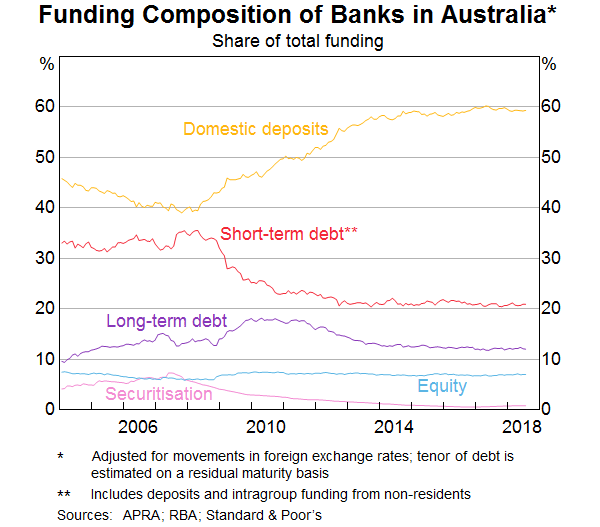
Box B
Money Creation Case Study
This box sketches out the process of money creation through loans and deposits at financial intermediaries on a fictional island, illustrating some of the concepts outlined in the main article.
The first two banks open
Currency – notes and coins – are widely used on our fictional island, but there has been no banking system – and therefore no deposits. Two commercial banks open their doors, one with $100 of equity and one with $50 of equity. The initial balance sheets of both banks are shown below (with cash representing the physical currency asset arising from the shareholders' equity) (Figure B1).
| Bank A | Bank B | |||||||
|---|---|---|---|---|---|---|---|---|
| Assets | Liabilities | Assets | Liabilities | |||||
| Cash | 100 | Equity | 100 | Cash | 50 | Equity | 50 | |
A borrower arrives
Let's first consider the case where a customer (Borrower 1) turns up at Bank A seeking a loan of $80. If Bank A decides to make the loan, as a first stage they record a loan asset and credit the customer's deposit account with the funds (Figure B2). The customer then withdraws $75 to use, decreasing Bank A's cash holdings and deposit liability (Figure B3). This highlights that, in order to make the loan, Bank A needs to hold sufficient cash (liquidity) to enable it to pay out the funds when the loan is drawn down. Note that, if the customer had wanted to borrow $120 and Bank A agreed to lend them this amount, then Bank A would have had insufficient cash (liquidity) if their customer wanted to withdraw the entire value of the loan; in addition, as the loan would have exceeded the entire amount of equity available to the bank, if the borrower were unable to repay the loan then the bank's equity (capital) would have been wiped out.
| Bank A | Bank B | |||||||
|---|---|---|---|---|---|---|---|---|
| Assets | Liabilities | Assets | Liabilities | |||||
| Cash | 100 | Deposit | 80 | Cash | 50 | Equity | 50 | |
| Loan | 80 | Equity | 100 | |||||
| Bank A | Bank B | |||||||
|---|---|---|---|---|---|---|---|---|
| Assets | Liabilities | Assets | Liabilities | |||||
| Cash | 25 | Deposit | 5 | Cash | 50 | Equity | 50 | |
| Loan | 80 | Equity | 100 | |||||
Bank A's customer then uses the $75 they have withdrawn to pay a business (Depositor 1), who deposits that money with Bank B (Figure B4).
| Bank A | Bank B | |||||||
|---|---|---|---|---|---|---|---|---|
| Assets | Liabilities | Assets | Liabilities | |||||
| Cash | 25 | Deposit | 5 | Cash | 125 | Deposit | 75 | |
| Loan | 80 | Equity | 100 | Equity | 50 | |||
A second borrower arrives
Now a new customer (Borrower 2) approaches Bank B wanting to borrow $40. If Bank B decides to make the loan, and the customer withdraws the entire amount of credited funds, Bank B's balance sheet will look as follows (Figure B5). Note that if Bank B had lent more than $50 this would have left Bank B in a position where it may have had insufficient liquidity (cash) to cover its deposits and insufficient capital to survive if the borrower were to default.
| Bank A | Bank B | |||||||
|---|---|---|---|---|---|---|---|---|
| Assets | Liabilities | Assets | Liabilities | |||||
| Cash | 25 | Deposit | 5 | Cash | 85 | Deposit | 75 | |
| Loan | 80 | Equity | 100 | Loan | 40 | Equity | 50 | |
If the $40 withdrawn from Bank B is used to pay a merchant who in turn deposits the funds at Bank A (Depositor 2), the result is shown in Figure B6.
| Bank A | Bank B | |||||||
|---|---|---|---|---|---|---|---|---|
| Assets | Liabilities | Assets | Liabilities | |||||
| Cash | 65 | Deposit | 45 | Cash | 85 | Deposit | 75 | |
| Loan | 80 | Equity | 100 | Loan | 40 | Equity | 50 | |
Money creation
With two loan customers and two deposit customers undertaking transactions, the banks have made a combined $120 in loans and have accrued $120 in deposits across the system. The extension of loans led to the creation of deposits in the banking system and hence an increase in money in the economy (cash plus deposits). However, the bank making each loan did not necessarily create a deposit at their own institution as funds may be withdrawn for use elsewhere.
More importantly, this example highlights that the creation of loans (and deposits) depends on a number of decisions – of the borrower to approach the bank and the bank to extend the loan. And the process is constrained by the need for the banker (and its regulator) to ensure sufficient liquid assets to meet expected withdrawals (both drawdowns relating to the new loan and withdrawals by existing deposit customers) and sufficient equity to absorb any losses from loans that are not fully repaid. These constraints are also going to be influenced by financial market conditions, including the willingness of investors to place equity with the banks and to hold any debt that they may issue. Again, all of these various capital and liquidity management constraints limit the ability of banks to write loans and create deposits.
Measures of Money
As discussed above, the most commonly used types of money in modern day Australia are currency and Australian dollar deposits at Australian financial institutions. However, the degree to which certain types of deposits exhibit money-like characteristics varies – for example, it may not be possible to use a term deposit that expires in a year's time to pay for a loaf of bread you want to buy today. Hence, it is common to produce a range of different measures of the stock of money. These are commonly called ‘monetary aggregates’. The narrower aggregates typically include only those products that are the most money-like in terms of the characteristics covered above. In contrast, the broader aggregates contain products that may be less money-like on one or more of the characteristics, but which can still be thought of as having many of the features of money.
In line with international norms, the RBA publishes key monetary aggregates each month: currency, M1, M3, broad money and base money (Table 1).
In general terms, currency, M1, M3 and broad money represent money-like liabilities of Australian financial intermediaries with respect to Australian households and businesses that are not financial intermediaries. The term AFI (all financial intermediaries) is used to denote intermediaries such as ADIs – such as banks and credit unions and building societies (CUBS) – and registered financial corporations (RFCs) that are treated as money issuers. Money-like liabilities of AFIs with respect to other money issuers, the government and non-residents are generally excluded from the monetary aggregates.[16] The measures therefore represent the money holdings of private sector Australian residents outside the banking sector.
The money base represents the money-like liabilities of the central bank.[17] Historically, growth in the money base has had close links to the expansion of bank balance sheets and credit creation through fractional reserve (or similar) requirements.[18] It has become less relevant (and received less attention) in recent decades as these requirements have been removed. Following the period of financial deregulation in the 1980s, these constraints have been replaced by the various requirements of the market and the prudential regulator regarding liquidity and capital adequacy, partly decoupling banks' balance sheets from central bank liabilities.
| Measure | Description(a) | Value $ billion | Share of nominal GDP Per cent |
|---|---|---|---|
| Currency | Holdings of notes and coins by the private non-bank sector | 74 | 4 |
| M1 | Currency + current (cheque) deposits of the private non-bank sector at banks | 357 | 19 |
| M3 | M1 + all other deposits of the private non-ADI sector at banks (including certificates of deposit) + all deposits of the private non-ADI sector at CUBS | 2,086 | 113 |
| Broad money | M3 + other deposit-like borrowings of AFIs from the non-AFI private sector (such as short-term debt securities) | 2,096 | 114 |
| Money base | Currency + banks' holdings of notes and coins + deposits of banks with the Reserve Bank + other Reserve Bank liabilities to the private non-bank sector | 109 | 6 |
|
(a) These descriptions abstract from some detail. See the Financial Aggregates release for more information. Source: ABS; APRA; RBA |
|||
We can use these measures to monitor growth in different types of money. Over the past two decades, M3 and broad money have shared a similar trajectory, increasing as a share of GDP. The two series are now almost indistinguishable (Graph 2). Unsurprisingly, their growth rates have also been quite similar, averaging just below 10 per cent per annum over the past two decades (Graph 3).[19] M1 has also increased as a share of nominal GDP over the past few decades, although it has been broadly stable over the 2000s. Currency and the money base have been little changed as a share of nominal GDP over the period shown.[20] While the growth rates of the money base and M1 have been lower, they have also been more volatile.
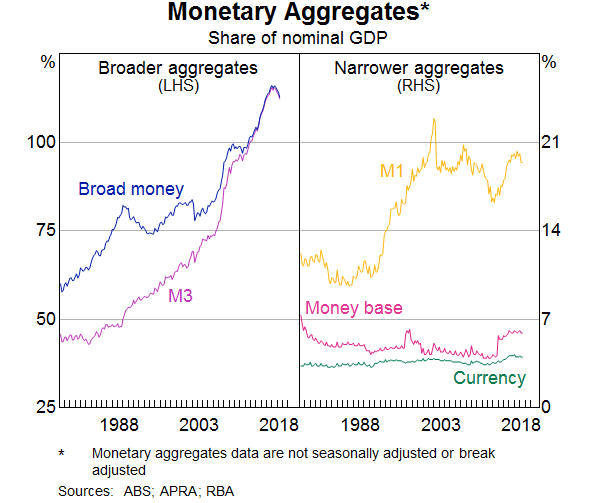
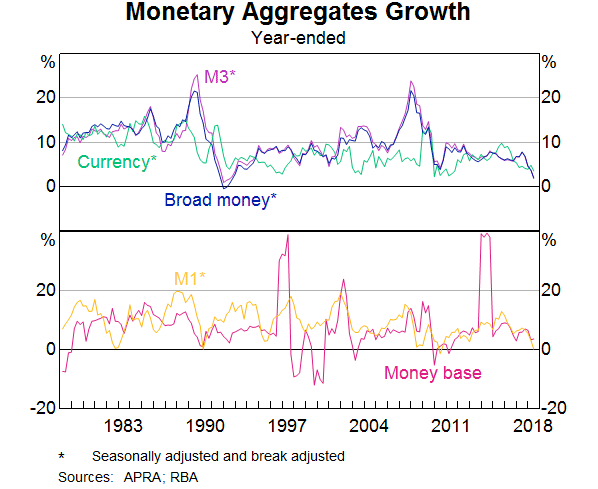
The sharp increase in the growth of M3 and broad money prior to and immediately following the global financial crisis was driven initially by rapid growth in certificates of deposit issued by banks, followed by very strong growth in term deposits and other non-cheque deposits issued by banks. This growth in banks' deposit funding is consistent with the compositional shift towards deposit funding discussed above.
What Can Measures of Money Tell Us about the Economy?
There are various reasons why, at least in theory, we might expect to observe a relationship between the value of money in circulation and economic activity and/or inflation. Given money's role as a widely accepted means of payment, the amount of financial assets held in the form of money – as opposed to less liquid assets such as property or shares – could be expected to have a link with expected near-term purchases. For example, we might expect that household deposits would provide an indication of expected household consumption. Secondly, given the link between money and credit, we would expect money growth to tend to increase when credit growth increases, which in turn may be associated with a higher level of (nominal) economic activity.
The potential relationships between money, economic activity and inflation have been used by central banks in different ways throughout history. In particular, measures of the money stock have been used to provide an indicator of economic activity. As monetary aggregates are typically published with a shorter delay and at a higher frequency than measures of economic activity such as GDP, they may provide early information if the aggregates have a reliable contemporaneous relationship with activity.
In addition, there have been times when the money stock has been an intermediate target of monetary policy. This approach to monetary policy – which was commonly used in the 1970s and 1980s, including in Australia – differs from approaches that target an interest rate, such as the cash rate, as an intermediate target of monetary policy.[21] However, in the later part of the twentieth century, a wave of financial deregulation and innovation led to the relationship between money growth and economic activity becoming increasingly unreliable. ‘Box C: The Velocity of Money’ provides an illustration of the change in the relationship between monetary aggregates and economic activity through the decline in the velocity of money. This change in the relationship between money and activity prompted many central banks to move away from using monetary aggregates as a target for monetary policy.
Box C
Velocity of Money
The use of monetary aggregates as an intermediate target for monetary policy was strongly influenced by the theory of monetarist economics. A central proposition of this theory was the quantity theory of money, which implies that a change in the money supply leads to a proportionate change in nominal GDP if the velocity of money – the frequency at which a unit of money is used to purchase final goods and services included in nominal GDP – remains constant.[22],[23] If this latter condition were to hold, then it was considered that the monetary aggregates would exhibit a stable relationship with inflation and output and that controlling money growth would, therefore, result in predictable outcomes for these variables.
However, shifts in the relationship between M3 – the monetary target used by the Reserve Bank between 1976 and 1985 – and nominal income in the early 1980s led to the abandonment of monetary targeting in Australia.[24] One way in which the shifts in these relationships can be seen is through examining the velocity of M3 (or other monetary aggregates) (Graph C1). The financial deregulation of the 1980s is frequently cited as driving the breakdown in the expected relationship between monetary aggregates and nominal income. This more recent data shows that the velocity of money has continued to decline following the period of rapid deregulation. As is shown in the next section, the relationship between growth in nominal GDP and growth in monetary aggregates has continued to vary over the past few decades.
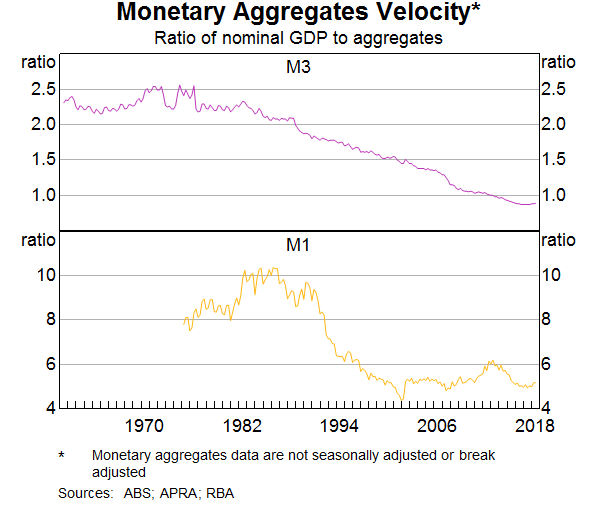
It is likely that the financial deregulation of the 1970s and 1980s has influenced the behaviour of the financial aggregates in more recent times. The well-documented rise in credit as a share of GDP can help to explain the trajectory of broad money as a share of GDP (the inverse of velocity) given the role of lending in deposit creation (Graph C2).[25] The phenomenon of credit increasing as a share of GDP was common to many advanced economies over this period.
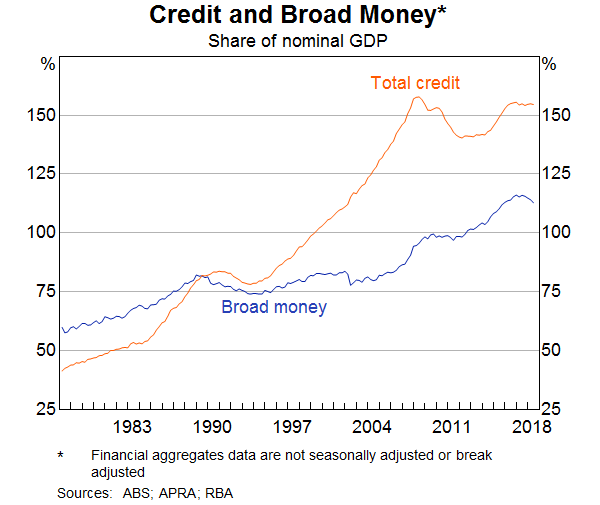
How close has the relationship between money and economic activity been for Australia more recently?
Simple graphs of annual growth in selected monetary aggregates and nominal non-farm GDP allow us to get a general sense of the relationship between these variables over recent decades (Graph 4). The narrower M1 measure does not show much evidence of a clear relationship with non-farm GDP throughout the period shown. In contrast, there is evidence of a relationship between broad money and non-farm GDP over the period shown.
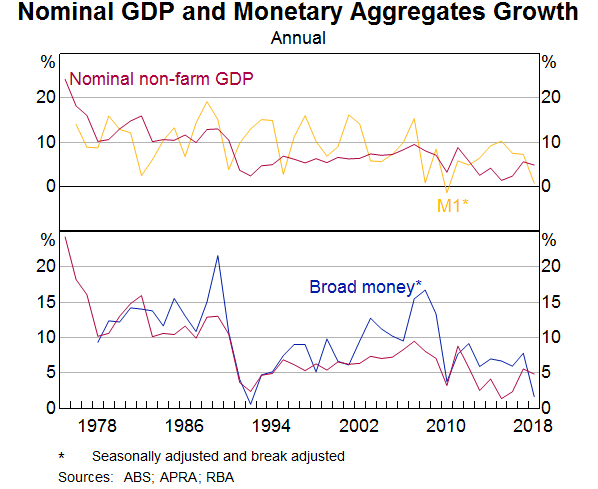
To analyse this further, we calculate contemporaneous correlations between growth in the monetary aggregates and growth in selected activity and price variables over the period June 1978 to June 2018.[26] Correlations between some of the narrower monetary aggregates – base money and M1 – and nominal activity variables – non-farm GDP, private business investment and household consumption expenditure – are weak and statistically insignificant (Table 2). In contrast, the correlations of both currency and the broader monetary aggregates with nominal activity variables are stronger and statistically significant. These correlations are strongest for the broadest aggregate – broad money – and for the broadest activity measure – nominal non-farm GDP – rather than its components. Correlations of the monetary aggregates with prices are weaker than those with nominal non-farm GDP, but stronger than the correlations between the monetary aggregates and real activity variables.[27]
| Currency | Base money | M1 | M3 | Broad money | |
|---|---|---|---|---|---|
| Nominal Non-farm GDP | 0.53** | 0.03 | 0.16 | 0.66** | 0.77** |
| Nominal Private Business Investment | 0.33** | 0.02 | 0.21 | 0.48** | 0.56** |
| Nominal Household Consumption Expenditure | 0.46** | −0.07 | 0.05 | 0.52** | 0.64** |
| Non-farm GDP Implicit Price Deflator (IPD) | 0.36** | −0.11 | −0.05 | 0.48** | 0.58** |
| Real Non-farm GDP | 0.08 | 0.11 | 0.23 | 0.28* | 0.31** |
| Real Private Business Investment | 0.10 | 0.01 | 0.16 | 0.34** | 0.37** |
| Real Household Consumption Expenditure | −0.41** | −0.23 | −0.33** | 0.23 | 0.24 |
|
(a) All monetary aggregates other than base money are seasonally adjusted and adjusted for breaks to the series. Base money is neither seasonally adjusted nor break adjusted. One asterisk indicates statistical significance at the 10 per cent level and two asterisks indicate statistical significance at the 5 per cent level. Statistically significant positive relationships are shown in bold. Sources: ABS; APRA; RBA |
|||||
Given that financial deregulation has been linked to a breakdown in the relationship between monetary aggregates and activity measures, we can examine whether the relationship has re-established itself more recently. One way to do this is to estimate correlations over a rolling window. The calculated correlations between broad money and nominal non-farm GDP over a 5- or 7-year rolling window show that the relationship has changed substantially over the past few decades (Graph 5). During the 1980s, the calculated correlation ranged from moderately strong to very weak and back to very strong. While this strong correlation persisted through the early 1990s, it was replaced by a very strong negative correlation towards the end of the 1990s. Over the past 15 years, the calculated correlations have averaged around 0.6, although with some variation over time. This indicates that the relationship has continued to vary following the period of financial deregulation.
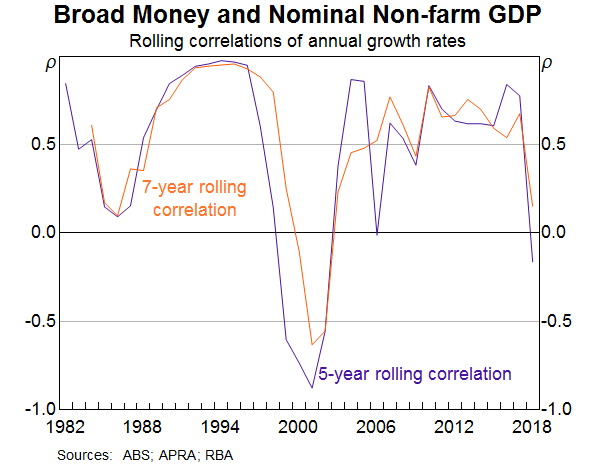
One of the key questions addressed by Reserve Bank research on the monetary aggregates in the 1980s and 1990s was whether they contained some information about future economic activity; this research generally found little evidence in favour of this proposition in the post-deregulation period.[28] While updated tests of this question are beyond the scope of this article, we can use correlations to get some sense of the relationship. When compared to the contemporaneous correlations, the relationship between the growth of the broader money measures in the current period and the growth of nominal non-farm GDP one year in the future weakens. In contrast, the relationship between current growth in M1 and future growth in various economic activity measures strengthens; however, the correlations are relatively weak at between 0.3 and 0.5 (see Table A1 in Appendix A). These results are broadly consistent with previous Reserve Bank research suggesting that the monetary aggregates have limited use as an indicator of future activity.
Conclusion
The most commonly used forms of money in Australia are currency and deposits, although other similar products can also be considered to be money to the extent that they can be readily made liquid for the purposes of purchasing goods, services or assets. Hence, there are various measures of the money stock starting from the very liquid forms and ranging up to broader aggregates that include somewhat less liquid forms of money. Money creation primarily occurs via the extension of loans by financial intermediaries. However, their ability to do so is subject to various limitations, including the need to ensure that lenders maintain sufficient liquidity and capital. Correlation analysis indicates that the relationship between growth in the money stock and various measures of economic activity has varied somewhat over recent decades. Over the entire period since the late 1970s, there is a reasonably strong contemporaneous correlation between growth in broad money and nominal activity; the relationship with real activity in the current period or future economic activity is weaker.
Appendix A Additional Correlation Results
| Currency | M1 | M3 | Broad money | |
|---|---|---|---|---|
| Nominal Non-farm GDP | 0.48** | 0.29* | 0.41** | 0.56** |
| Nominal Private Business Investment | 0.17 | 0.49** | 0.06 | 0.16 |
| Nominal Household Consumption Expenditure | 0.62** | 0.29* | 0.47** | 0.61** |
| Non-farm GDP Implicit Price Deflator (IPD) | 0.62** | 0.24 | 0.43** | 0.57** |
| Real Non-farm GDP | 0.05 | 0.53** | −0.09 | −0.05 |
| Real Private Business Investment | −0.07 | 0.43** | −0.08 | −0.03 |
| Real Household Consumption Expenditure | −0.03 | 0.33** | 0.11 | 0.11 |
|
(a) All monetary aggregates are seasonally adjusted and adjusted for breaks to the series. One asterisk indicates statistical significance at the 10 per cent level and two asterisks indicate statistical significance at the 5 per cent level. Statistically significant positive relationships are shown in bold. Sources: ABS; APRA; RBA |
||||
Footnotes
The authors are from Domestic Markets Department. [*]
Something can be a poor store of value if it depreciates in value quickly – ice-creams are unlikely to be a good store of value in a very hot climate without freezers. Things that fluctuate (alternatively appreciate and depreciate) in value can also be poor stores of value because the redeemable value may be lower than expected when you want to undertake a transaction. [1]
The notion of goods possessing money-like characteristics of varying degrees is expressed by Hayek (1990; p 56): ‘… it would be more helpful for the explanation of monetary phenomena if “money” were an adjective describing a property which different things could possess to varying degrees’. A similar sentiment can be found in Keynes (1973). [2]
Exceptions include countries where multiple currencies (for example, a local currency and a foreign currency) are in use. [3]
On a topical side note, Richards (2018) notes that bitcoin shares very few of the attributes of other currencies or monies. [4]
This generalisation abstracts from the details of what is included in specific types of monetary aggregates; the ‘Measures of Money’ section contains more information. Lowe (2017) and Richards (2018) provide thoughts on whether there might be a case for the RBA to issue a digital form of the Australian dollar – an ‘eAUD’ – in the future. [5]
Prudential oversight helps to ensure that, unlike some other financial instruments, (retail) deposits typically do not fluctuate in value based on the performance of the ADI. Deposit insurance provides a backstop to that. [6]
This and more information is available at the RBA Museum website: <<http://museum.rba.gov.au/>> [7]
For more information on the RBA's issuance of banknotes see the Reserve Bank's annual report, available at <http://www.rba.gov.au/publications/annual-reports/rba/2017/banknotes.html> and Flannigan & Staib (2017). [8]
As banks account for the vast bulk of the ADI sector's deposit liabilities – and total liabilities – the term ‘bank’ is generally used interchangeably with ‘ADI’ in this text; Graph 1 and Table 1 are exceptions to this general case. [9]
As is described in the ‘Measures of Money’ section below, cash held by financial intermediaries such as ADIs is typically excluded from measures of money. [10]
A thorough exposition of this concept can be found in McLeay, Radia & Thomas (2014). [11]
The simplest case would be one in which the buyer of the bond holds a deposit at the same bank. [12]
As discussed in the section on ‘Measures of Money’, bonds are not considered to be money. The effect on the money stock will also depend on whether the buyer is a money issuer – see ‘Measures of Money’. [13]
The reasons for this change in funding composition have been extensively covered in other RBA publications; for example, see Battellino (2009), Debelle (2010) and sections 4.2.1.3 and 5.5.2 of RBA (2014). [14]
This is true for narrower measures of the money stock. As noted in the section on ‘Measures of Money’, broader measures of the Australian money stock – such as broad money – include short-term debt securities as a type of money. For these measures, the substitution between these two classes would have no overall effect on the measured money stock. [15]
Considerations such as data availability mean that there are some exceptions to this general rule for particular liabilities and/or for particular monetary aggregates. [16]
The money base also includes coins on issue, which are not a liability of the Reserve Bank. [17]
For more information see Battellino & McMillan (1989) and Grenville (1991). [18]
As in the financial aggregates publication, the levels are not break adjusted or seasonally adjusted, while the growth rates are. [19]
The pronounced increase in the money base in 2013 was associated with the introduction of open repo (where repurchase agreements are contracted without a maturity date) to support the same day settlement of Direct Entry payments; volatility in the money base in the mid 1990s was associated with preparations for the introduction of a real-time gross settlement (RTGS) system in Australia. [20]
See Edey (1997) for a discussion of various possible monetary policy systems. [21]
This is represented by the equation MV = PY where M represents the money supply (or stock), V represents the velocity of money and PY represents nominal GDP. [22]
More recent versions of the quantity theory of money assert that velocity is a function of a small number of variables that influence the demand for money, including interest rates, income and inflation expectations (e.g. Friedman 1956). [23]
See, for example, Macfarlane (1998) and Fraser (1994). [24]
For more background on the increase in credit to GDP in Australia, see Battellino (2007). The RBA's submission to the Financial System Inquiry provides a more recent perspective and details the drivers of growth in the financial sector more broadly (see in particular Chapter 2 of RBA (2014)). [25]
Correlations are calculated on growth rates of annual (end-June) observations, with the activity and prices data constructed from the quarterly national accounts. The calculated correlation coefficients are bounded between 1 (indicating perfect positive correlation) and −1 (indicating perfect negative correlation), with 0 indicating no correlation. A finding that the correlation is ‘statistically significant’ indicates that there can be some confidence that the underlying correlation between those two variables is not zero. [26]
This latter finding is not surprising given that both nominal non-farm GDP and (nominal) broad money will tend to share a common trend relating to prices. [27]
While research using simple correlations (such as Bullock, Morris & Stevens (1988)) found some evidence of a leading role for a narrower monetary aggregate, research relying on more formal techniques finds little evidence of a leading relationship for any of the monetary aggregates or that they do little to improve forecasting performance in models with other variables (see Bullock, Stevens & Thorp (1988), Stevens and Thorp (1989) and Tallman and Chandra (1996, 1997)). More recent analysis (Norman & Richards 2010) found some evidence that money may be empirically relevant for future inflation, but concluded that the relationship was not strong enough to justify inclusion in inflation models. [28]
References
Battellino R and N McMillan (1989), ‘Changes in the Behaviour of Banks and Their Implications for Financial Aggregates’, RBA Research Discussion Paper No 8904.
Battellino R (2007), ‘Some Observations on Financial Trends’, Address to Finsia-Melbourne Centre for Financial Studies 12th Banking and Finance Conference, Melbourne, 25 September.
Battellino R (2009), ‘Some Comments on Bank Funding’, Remarks to the 22nd Australasian Finance & Banking Conference, Sydney, 16 December.
Bullock M, G Stevens & S Thorp (1988), ‘Do Financial Aggregates Lead Activity?: A Preliminary Analysis’, RBA Research Discussion Paper No 8803.
Bullock M, D Morris & G Stevens (1988), ‘The Relationship between Financial Indicators and Economic Activity: 1968–1987’, RBA Research Discussion Paper No 8805.
Debelle G (2010), ‘Bank Funding and Capital Flows’, 23rd Australian Finance and Banking Conference, Sydney, 15 December.
Edey M (1997), ‘The Debate on Alternatives for Monetary Policy in Australia’, in P Lowe (ed), Monetary Policy and Inflation Targeting, Proceedings of a Conference held at the H.C. Coombs Centre for Financial Studies, Kirribilli, pp 42–67.
Flannigan G and A Staib (2017), ‘The Growing Demand for Cash’, RBA Bulletin, September, pp 63–74.
Fraser B (1994), ‘The Art of Monetary Policy’, Talk to the 23rd Conference of Economists, Surfers Paradise, 26 September.
Friedman M (1956), ‘The Quantity Theory of Money: A Restatement’, in M Friedman (ed), Studies in the Quantity Theory of Money, University of Chicago Press, pp 3–21.
Grenville S (1991), ‘The Evolution of Financial Deregulation’, in I Macfarlane (ed), The Deregulation of Financial Intermediaries, Proceedings of a Conference held at the HC Coombs Centre for Financial Studies, Kirribilli, pp 3–35.
Hayek FA (1990), Denationalisation of Money – the Argument Refined: An Analysis of the Theory and Practice of Concurrent Currencies, third edition, The Institute of Economic Affairs, London.
Keynes JM (1973), The General Theory of Employment, Interest and Money, fifteenth edition, Macmillan Press, London.
Lowe P (2017), ‘An eAUD?’, Address to the 2017 Australian Payment Summit, Sydney, 13 December.
Macfarlane I (1998), ‘Australian Monetary Policy in the Last Quarter of the Twentieth Century’, Shann Memorial Lecture, University of Western Australia, 15 September.
McLeay M, A Radia & R Thomas (2014), ‘Money creation in the modern economy’, Bank of England Quarterly Bulletin, Q1, pp 14–27. Available at <https://www.bankofengland.co.uk/-/media/boe/files/quarterly-bulletin/2014/money-creation-in-the-modern-economy.pdf>.
Norman D and Richards A (2010), ‘Modelling Inflation in Australia’, RBA Research Discussion Paper No 2010-03.
Reserve Bank of Australia (RBA) (2014), ‘Submission to the Financial System Inquiry’, March.
Richards T (2018), ‘Cryptocurrencies and Distributed Ledger Technology’, Australian Business Economists Briefing, Sydney, 26 June.
Stevens G and S Thorp (1989), ‘The Relationship between Financial Indicators and Economy Activity: Some Further Evidence’, RBA Research Discussion Paper No 8903.
Tallman EW and N Chandra (1996), ‘The Information Content of Financial Aggregates in Australia’, RBA Research Discussion Paper No 9606.
Tallman EW and N Chandra (1997), ‘Financial Aggregates as Conditioning Information for Australian Output and Inflation’, RBA Research Discussion Paper No 9704.